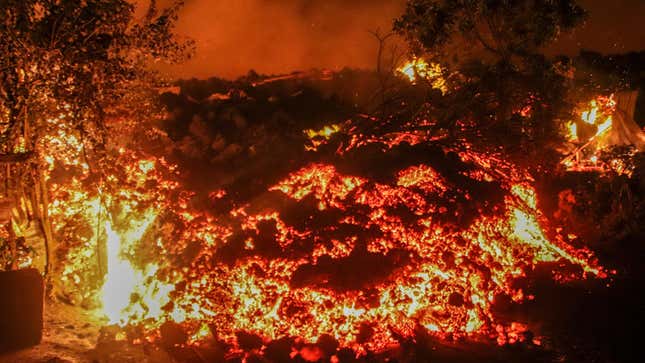
On Saturday, the Democratic Republic of Congo’s Mount Nyiragongo volcano suddenly erupted, forcing thousands to flee to neighboring Rwanda to seek shelter. By Sunday, reports stated that the speed of Nyiragongo’s lava had slowed and that the nearby city of Goma, home to more than one million people, had been spared.
The eruption—which was caused when fractures opened in the volcano’s side and resulted in lava flowing in several directions—took residents, experts, and officials by surprise. According to Reuters, this was in part due to problems at the Goma Volcano Observatory, the scientific entity that monitors Nyiragongo, a volcano near the Democratic Republic of Congo’s border with Rwanda. Volcanologists have struggled to carry out basic checks on the volcano since the World Bank cut off its funding in light of embezzlement allegations.
Observatory officials had not done comprehensive seismic checks on the volcano since October of last year because they didn’t have an internet connection. They managed to reestablish their internet in April when they received funding from a U.S. partner. Officials said that by then, too much time had been lost, however.
“As soon as the internet was restored, we had started recording the warning signals, but since we did not have previous data, we thought it was the start of volcanic activity,” Celestin Kasereka Mahinda, the observatory’s scientific director, said. “Hence this surprise.”

Although it was a surprise to observatory officials, volcano watchers and experts had been sounding the alarm in recent months about a possible Nyiragongo eruption based on increased volcanic activity and other indicators.
Nyiragongo is one of the world’s most active and dangerous volcanoes and has erupted seven times in the last hundred years. Volcano expert Robin George Andrews noted that one of the reasons Nyiragongo is dangerous is that its lava is very fluid and fast, so fast that it can catch up to speeding cars. Volcanoes in this region also “belch out” a lot of carbon dioxide, he said, which sinks downslope and kills anyone engulfed by it.
News of the volcano’s eruption sparked panic in the surrounding area, which is still haunted by the volcano’s 2002 eruption that killed 250 people and left 120,000 homeless. Although the country’s government said that an evacuation plan had been activated, the official announcement came hours after the sky turned a fiery red on Saturday, the Associated Press reported, after many had already taken it upon themselves to flee.
An army spokesperson told Reuters on Sunday that 13 people had been killed while they were fleeing from the disaster. Of those that died, nine had been involved in a traffic accident and four had tried to escape from a prison in Goma.

Nonetheless, the number of deaths is expected to increase considerably based on initial eyewitness reports.
Nyiragongo’s lava destroyed hundreds of houses in the eastern part of the Democratic Republic of Congo. CNN stated that five schools had been decimated, while Reuters reported that cooled lava in some areas had turned to rubble. At some sites, it was three stories high, consuming large buildings and sending smoke into the sky.
On Sunday, people were beginning to return to their homes to assess what, if any, damage Nyiragongo had wreaked. After that, the monthslong restoration effort will begin.